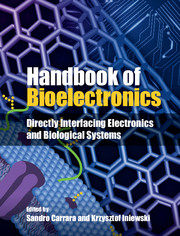Book contents
- Frontmatter
- Contents
- List of Contributors
- 1 What is bioelectronics?
- Part I Electronic components
- 2 Molecular components for electronics
- 3 Nanogaps and biomolecules
- 4 Organic thin-film transistors for biological applications
- 5 Protein-based transistors
- 6 Single-molecule bioelectronics
- 7 Nanoscale biomemory device composed of recombinant protein variants
- Part II Biosensors
- Part III Fuel cells
- Part IV Biomimetic systems
- Part V Bionics
- Part VI Brain interfaces
- Part VII Lab-on-a-chip
- Part VIII Future perspectives
- Index
- References
3 - Nanogaps and biomolecules
from Part I - Electronic components
Published online by Cambridge University Press: 05 September 2015
- Frontmatter
- Contents
- List of Contributors
- 1 What is bioelectronics?
- Part I Electronic components
- 2 Molecular components for electronics
- 3 Nanogaps and biomolecules
- 4 Organic thin-film transistors for biological applications
- 5 Protein-based transistors
- 6 Single-molecule bioelectronics
- 7 Nanoscale biomemory device composed of recombinant protein variants
- Part II Biosensors
- Part III Fuel cells
- Part IV Biomimetic systems
- Part V Bionics
- Part VI Brain interfaces
- Part VII Lab-on-a-chip
- Part VIII Future perspectives
- Index
- References
Summary
Characterization of molecular electronic transport is an active part of theresearch field in nanotechnology. The main underlying idea is to use singlemolecules as active elements in nanodevices [1]. As a consequence, theproper fabrication of a molecule–electrode contact is a crucial issue[2],[3] and several applications can be envisioned. For example, thevariation of the electrical conduction of metal–molecule–metaljunctions can be used in biosensing for electrochemical detection ofdifferent crucial biomarkers. Possible applications include biomedicaldiagnostics and the monitoring of biological systems. In particular, thedetection of single proteins might become the starting point for monitoringdrugs, developing clean energy systems, fabricating bio-optoelectronictransistors, and developing other innovative devices and systems.
The fabrication of nanogaps
Nanogap electrodes (NGEs, defined as a pair of electrodes separated by ananometer-sized gap) are fundamental tools for characterizing the electricproperties of material at the nanometer scale, or even at the molecularscale. They are also important building blocks for the fabrication ofnanometer-sized devices and circuits.
Molecular-based devices possess unique advantages for electronic applicationswith respect to conventional components [4], such as lower cost, lower powerdissipation and higher efficiency. Specific molecules can be not onlyrecognized, but also self-assembled on such NGEs, thus leading to elaborategeometries for the study of distinct optical and electronic properties.
Information
- Type
- Chapter
- Information
- Handbook of BioelectronicsDirectly Interfacing Electronics and Biological Systems, pp. 11 - 33Publisher: Cambridge University PressPrint publication year: 2015
